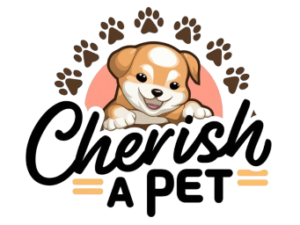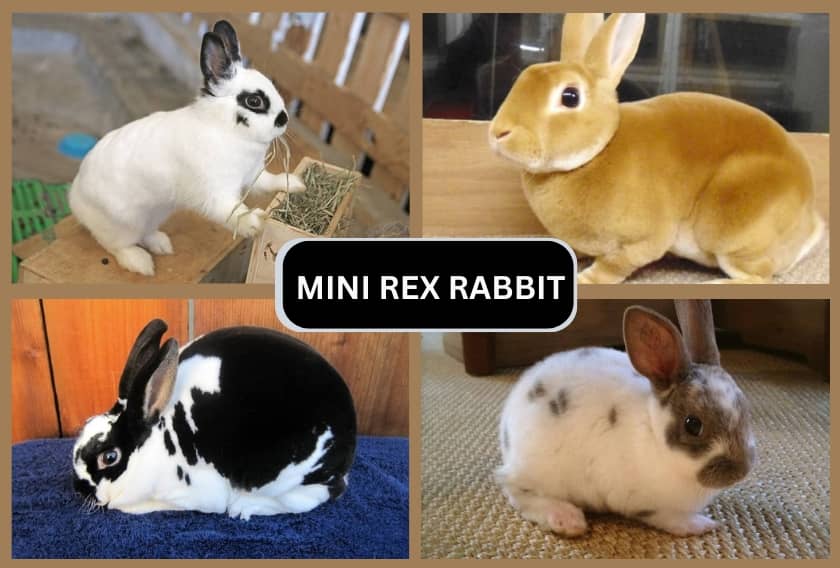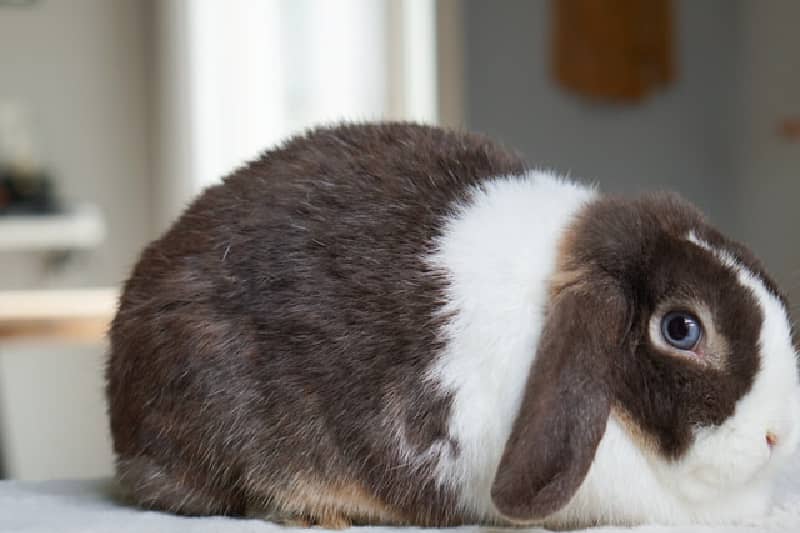Angora rabbits are among the oldest domestic rabbit breeds, originally bred for their incredibly soft and long wool. Angora rabbits originated in Ankara, historically known as Angora, and presently called Turkey. They were brought to France in the year 1723 and they made their way to the USA in 1840. They were bred for their long and silky wool which was in great demand during World War II.
Angora rabbits are best known for their luxurious, silky fur which is due to a recessive gene that causes this fur to grow at a fast pace of about 1” every month. These creatures are a great combination of sweet and silly.
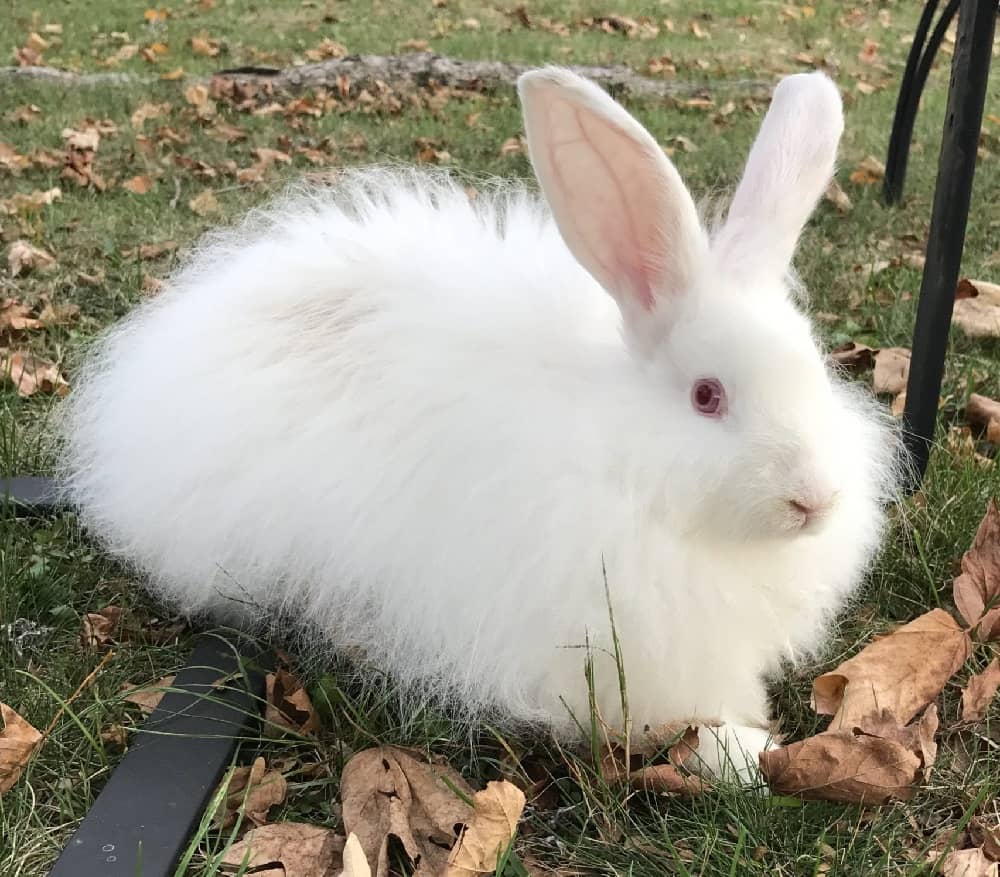
The scientific name of the Angora Rabbit is Oryctolagus cuniculus domesticus.
Their lengthy hair gives them an extra-fluffy appearance. However, the rabbit needs a particular maintenance regimen because of its long hair and other characteristics.
Angora rabbits require a lot of time and attention, particularly when it comes to maintenance since their fur or wool grows quickly and needs to be sheared or trimmed frequently.
Breeds of Angora Rabbits
An Angora rabbit can be divided into at least eleven different breeds, four of which are now recognized by the American Rabbit Breeders Association (ARBA): the English, French, Giant, and Satin Angoras.
All the breeds of Angora rabbits are fluffy and cute. All these breeds have some special characteristics and you can easily pick which one suits you the best.
English Angora
It is the smallest Angora breed with a weight of 5 to 7.5 pounds (2.3 to 3.4 kg). and a Life Expectancy of 5 to 12 years. They have wool on their face, ears, and feet. English Angoras have a compact body with a rounded head and a distinctive “halo” of wool around the face. This gives them a “teddy bear” look. They come in a variety of colors such as. Agouti, Broken, Pointed White, Ruby-eyed White, Self, and Shaded. Their ears could be folded over the tips. They have a dense and silky wool with a high yield.
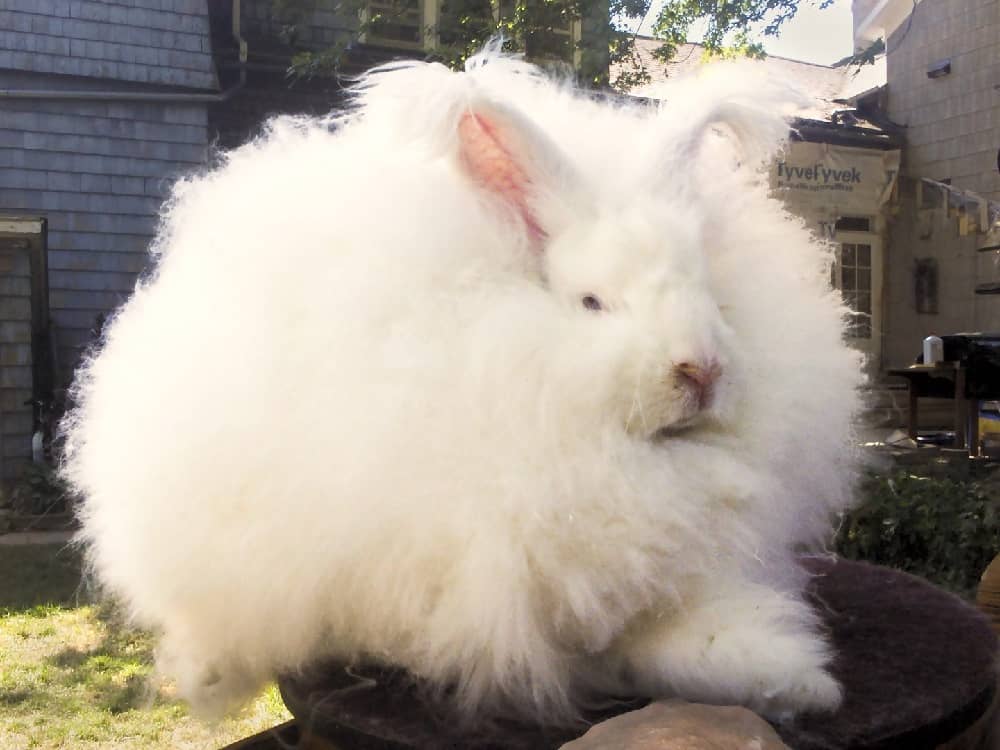
Their gentle and friendly temperament makes them popular pets. Due to their eye-catching personalities, this breed is also a show-table breed. As they have dense fur, English Angoras need frequent grooming to prevent matting. It is the only breed with fur covering its eyes.
French Angora
The French Angoras have a clear face and ears without wool, giving them a more streamlined look compared to English Angoras. Their round-shaped head, oval-shaped body, with plain or tufted ears, with tufting restricted to the tips of the ears give them a unique appearance. On looking the French Angora in its profile look, the body shape seems to be oval. The color of a French Angora is determined by the color of the forehead, feet, and tail. The ARBA has recognized colors such as Self, agouti, pointed white, broken, and shaded.

The French Angoras are a commercial breed for wool. Their wool is slightly coarser than English Angoras with an abundance of of guard hairs mixed in, providing a slightly more textured feel. The average weight of French Angora is around 7.5 to 10.5 pounds (3.4 to 4.8 kg). Their easy-care coats make a great choice for new Angora breeders and fiber enthusiasts. They also need regular grooming but less frequently as compared to English Angoras.
Giant Angora
As the name suggests, it is the largest Angora breed with a robust body with substantial wool coverage. It is also the heaviest of the Angoras typically 9.5 pounds(4.3kg) and above. The life expectancy of the Giant Angora is nearly 7 to 12 years.
The head of Giant Angora is oval and is broad across the forehead and slightly narrower at the muzzle. These were developed by breeding English Angoras with Flemish Giants. The Giant Angoras are available in various colors such as white, black, blue, chocolate, blue tort, black tort, and chestnut. Out of these only REW, Ruby-eyed white was recognized by ARBA in 1988. These are also called Albino rabbits.
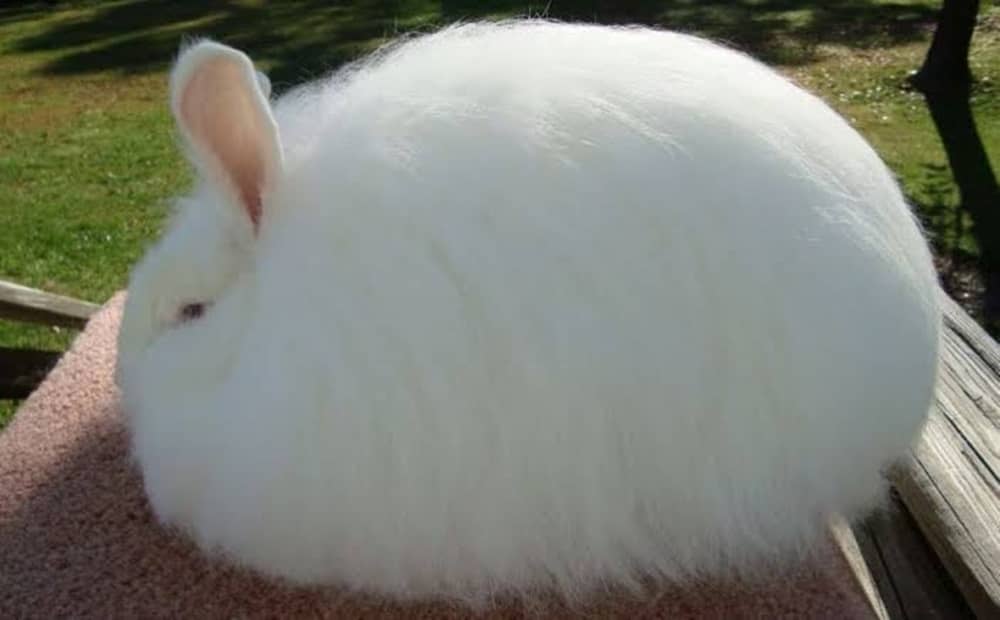
It is the only Angora breed that has three different fiber types, soft underwool(gentle waves and shine), awn fluff(crimped with a hooked end), and awn hair(guard hairs which are strong and straight). Due to their size and wool quantity, they need consistent grooming to maintain wool quality and prevent matting.
The Giant Angora doesn’t molt, therefore the wool must be shorn timely. These are some of the biggest producers of wool. The Giant Angoras are gentle, docile, and friendly and need plenty of time with their owners.
Satin Angora
The Satin Angora has a clear face with a distinct sheen to its coat. Satin Angora’s wool is noted for its exceptional luster and fine texture. It feels more like silk. The satin coat has a semi-transparent outer layer on the hair shaft that reflects light, giving the hair a great sheen, rich color, and incredibly smooth and silky texture. The sheen is evident over the entire body.
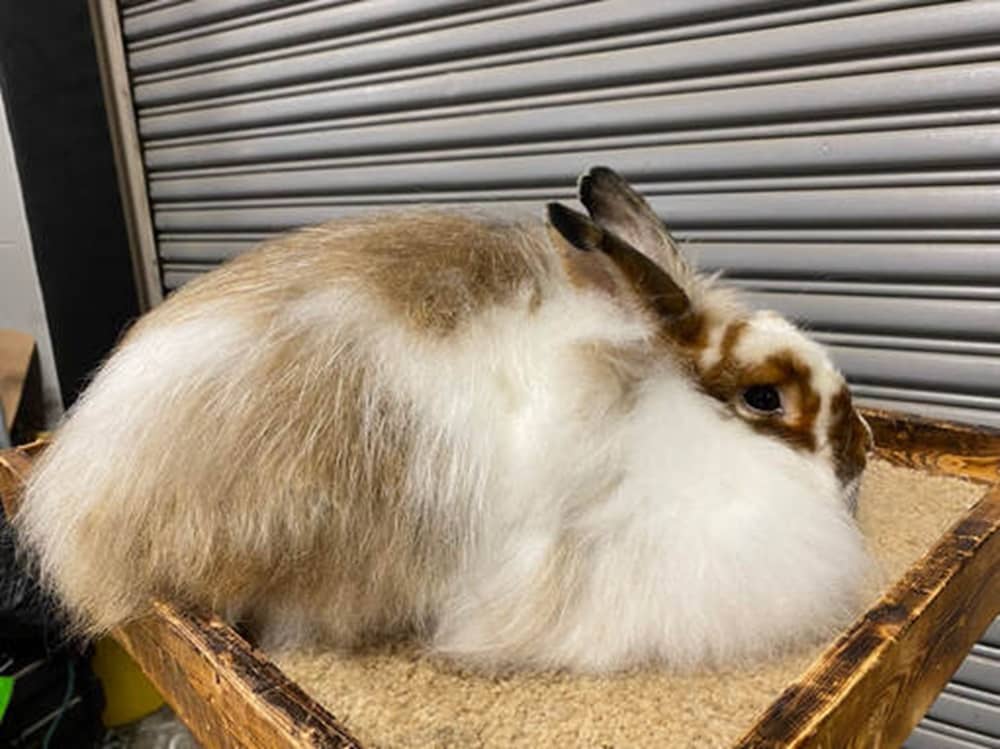
It has a medium-length body with an average weight of about 6.5 to 9.5 pounds ( (2.9 to 4.5 kg). Their sides have a slight taper from the headquarters to the shoulders. The Satin Angoras have an oval head, broad forehead, and narrower muzzle.
They have plain and erect ears or have a slight tuft however tufting is restricted to the tips of the ears. They have a Life Expectancy of 7 to 12 years. The Satin Angoras are friendly and playful and make great companions as pets. They need regular grooming to maintain the quality of their unique wool and prevent matting.
Each Angora breed has its specific charm and grooming needs, but all are cherished for their luxurious wool and gentle temperaments.
Male Vs. Female Angora Rabbits
Male Rabbits (Bucks): Bucks are typically more laid back and relaxed. They love socializing and can be quite affectionate. Neutering them can help prevent some unwanted behaviors like territorial marking.
Female Rabbits (Does): Does can be a bit more territorial and might show nesting behaviors. Spaying is not only beneficial for their health, preventing issues like uterine cancer, but also helps in moderating their temperament.
Behavior and Temperament of Angora Rabbits
Angora rabbits are known for their gentle and friendly nature. They’re curious little creatures that enjoy interacting with people.
Their calm demeanor makes them great pets for families, although it’s always a good idea to supervise interactions with very young children. Moreover, if you are committed to spending an hour with your bunny that can be for interaction, playing, or grooming of your pet Angora rabbit, then these are a good choice.
How to Care for Angora Rabbits?
Angora rabbits are fascinating and unique pets that require a significant commitment to their care and well-being. By providing a suitable environment, a balanced diet, regular health checkups, and ample social interaction, you can ensure your pet Angora rabbit lives a happy and healthy life.
Angora Rabbit Habitat
Angora rabbits can be kept indoors or outdoors, but they need a spacious, clean, and secure environment that is free from predators. Habitat of a minimum size of 36”x 30” is recommended for keeping an Angora Rabbit. You can add a ledge or a box to climb on, that will increase roaming space for your pet without increasing the size of the hutch. These boxes allow them to stand and look around and make the environment more engaging for your pet.
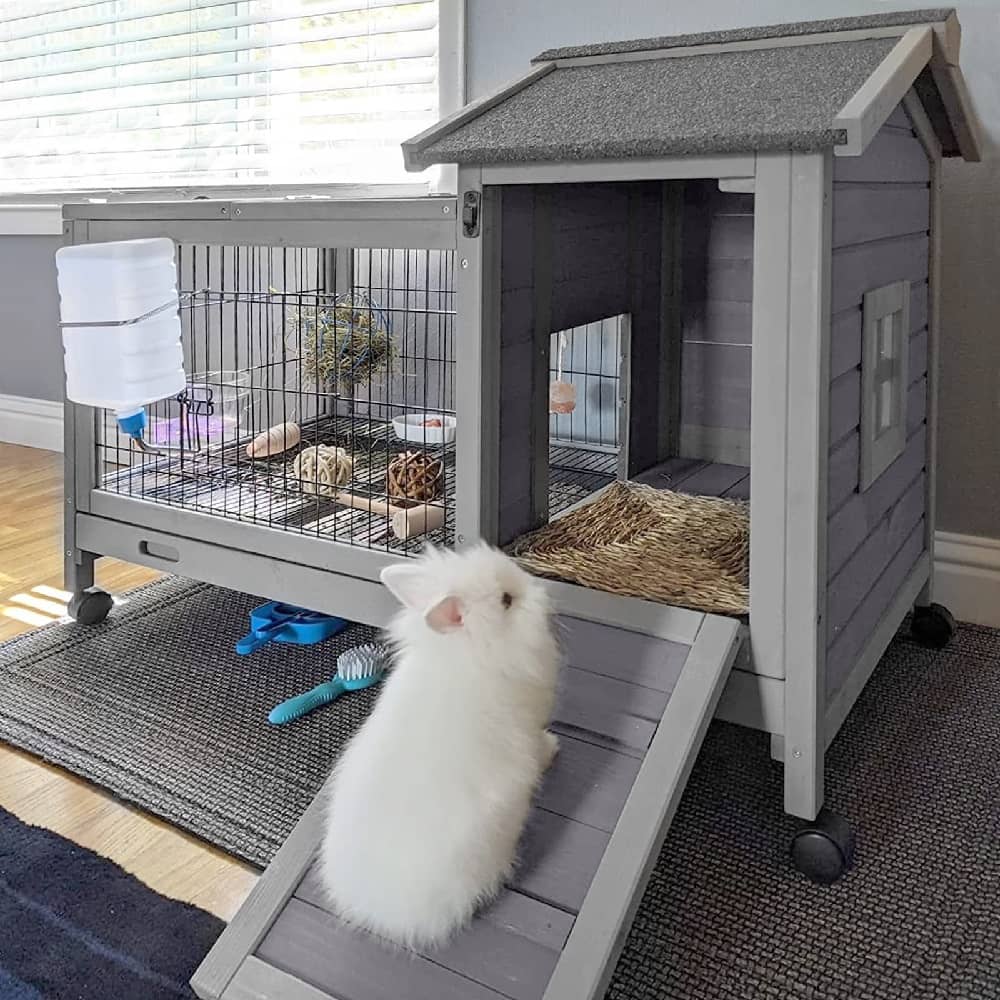
A roomy cage or hutch where they can move around comfortably is essential. The angora rabbits can withstand a temperature of 50-75 degrees Fahrenheit but these should be kept in shade.
Specific Substrate Needs
You should use bedding made of absorbent materials, such as hay, aspen shavings, or paper products. Pine and cedar shavings might irritate your respiratory system, so stay away from them.
Food dish
A balanced diet of high-quality rabbit pellets should be nearly 18% of the entire meal in a day, fresh hay (Timothy hay is ideal), and fresh vegetables are crucial.
Water Bottle
You should always provide fresh water through a water bottle only. As the Angora rabbits have long hair, the fur may become wet while drinking from a water dish. As a result matting of the fur will take place.
Litter Box
A litter box is a container made specifically to hold litter, a substrate that manages odors and absorbs waste. The size of the litter box should be nearly twice the size of your rabbit so as to allow it to sit and turn around comfortably. Safe litter should be used to fill it as well.
Exercise and Toys
Angora rabbits require a lot of exercises to maintain good health. Every day, give them some supervised time to hop and explore outside of their area. To keep them occupied, you might give them toys and chew blocks.
What Does an Angora Rabbit Eat and Drink?
Angora rabbits like to consume orchard grass, Timothy hay, and grass hay. You should provide unlimited access to hay as it needs a low-calorie, high-fiber diet, and high-protein diet. High-quality hay keeps their systems clean as they may ingest wool while grooming themselves.
They don’t require a fancy diet, a lot of fruits, or grains; they’re content with leaves and twigs. When it comes to feeding your rabbit, try carrot tops, parsley, dandelions, a handful of fresh grass, or any other fresh green vegetable. They thrive on a fairly simple diet.
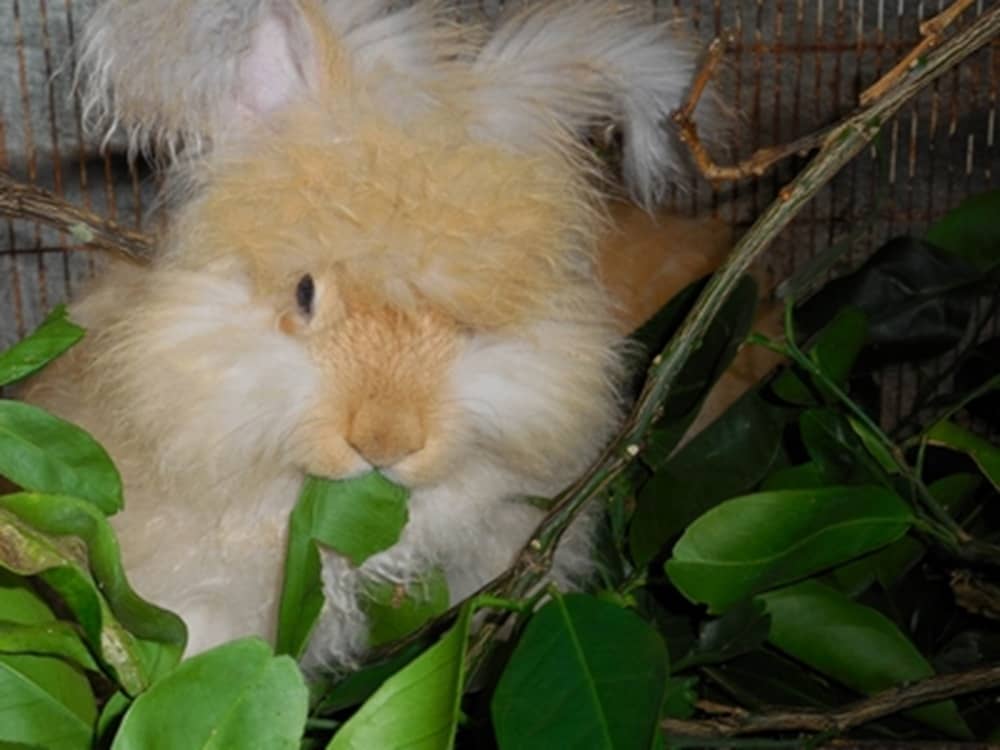
You should provide hay in a net so that it doesn’t stick on their feet. Your bunny will get adequate fiber from vegetables including celery leaves, carrot tops, parsley, green and red leaf lettuce, arugula, romaine, Boston Bibb, and butter lettuce. As a treat, you may give them low-glycemic fruits.
In the initial 4-6 months you can fully feed your rabbit and after 6 months you should cut down the amount as it may lead to obesity in your rabbits. You can give approximately ½ to ¾ cups of feed for English Angoras and ¾ cups to 1 cup for French and Satin Angoras. The diet can be slightly more for Giant Angoras.
To keep it hydrated, you should also put a clean bowl filled with fresh water or a water bottle inside its cage.
Handling of Angora Rabbits
Handle your Angora rabbit gently and always support its body properly to avoid injury. Regular interaction helps build a strong bond and trust between you and your pet.
Be kind and encouraging to your Angora rabbit when handling it. To help them feel secure, always support their hindquarters and keep them near your body.
Exercise for Angora Rabbits
Ensure that your Angora spends a minimum of four hours per day playing, exploring, and exercising outside of its cage. But make sure to bunny-proof your home before letting your pet go free.

To get your rabbit moving, you should provide different toys to forage food, DIY puzzles, tunnels, and other items.: These bunnies need daily exercise. Let them roam in a safe, enclosed area for a few hours each day to keep them happy and healthy.
Common Health Problems in Angora Rabbits
The Angora Rabbits are prone to certain health problems due to their dense wool. Some of the major concerns are:
Wool block
It is a serious condition that arises due to the ingestion of wool while angoras are grooming themselves, especially during molting. To avoid this situation, the angora rabbits should be well-groomed or sheared regularly. Prevention is the only key to saving your bunny from developing a hairball inside its digestive system. Moreover, by providing a high fiber in their diet, there are comparatively fewer chances of hair obstruction. Plenty of exercise is crucial for your furry friend.
GI Stasis
In rabbits with gastrointestinal (GI) stasis, typical bacteria in the digestive tract fall out of balance and there is a decrease in the contractions of the muscles surrounding the stomach and intestines. Due to this condition, the passage of food from the digestive tract slows down. The condition arises due to stress, pain, illness, or poor diet.
Fly strike
Flies tend to nest and lay eggs in their long hair particularly if it is matted or dirty. The fly eggs hatch into maggots and these in turn create wounds and severe infections.
Dental issues
Overgrown teeth can cause pain and eating difficulties. Regular check-ups and providing chew toys can help. Your bunny needs to be seen by a veterinarian if you observe that they are not eating well, are pawing at their face, drooling, or have swelling or pain on their face.
Spinal Injury
The Rabbits don’t like to be picked. If a rabbit struggles and jumps out of the person’s arms, it may break its back.
Signs of Ill Health
You should look for changes in appetite, droppings, behavior, and grooming habits. Additionally, any sign of lethargy, labored breathing, or discharge from the eyes or nose warrants a vet visit.

Lethargy: A normally active rabbit that becomes lethargic may be ill.
Loss of Appetite: Refusal to eat or drink can indicate a health problem.
Changes in Droppings: Unusual droppings can signal digestive issues.
Respiratory Issues: Sneezing, wheezing, or nasal discharge can indicate respiratory infections.
Changes in paws: If the paws are not crusty and yellow, it is a sign of wiping the nose.
Ears: If you find your rabbit frequently scratching his ears, it is an indication of wax deposits and the growth of bacteria.
Where to Buy Angora Rabbit?
Purchasing Angora rabbits can be done through various channels, ensuring you choose reputable sources to find healthy and well-cared-for rabbits. You can check with breeder associations such as the American Rabbit Breeders Association (ARBA) or breed-specific clubs like the National Angora Rabbit Breeders Club (NARBC) for lists of reputable breeders.
Rabbit shows and Expos are great places to meet authentic and reputable Breeders who can provide detailed information on care, grooming, and rabbit lineage. You can also check some online marketplaces where they list available angoras.
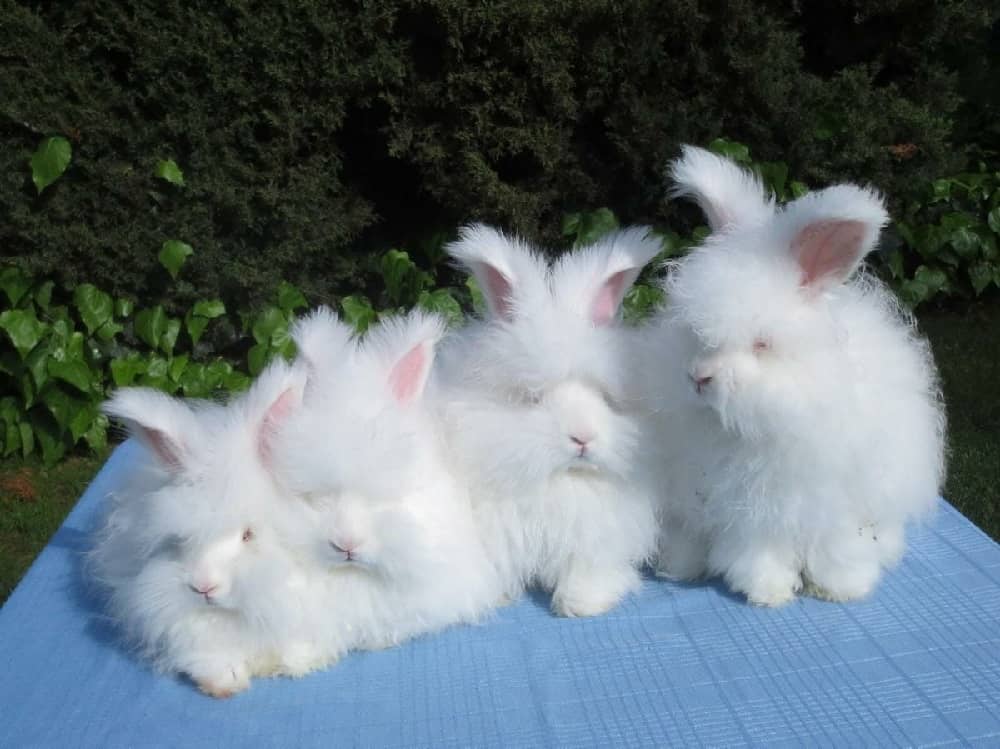
Occasionally, Angora rabbits may be available for adoption through rabbit rescues or animal shelters. Adopting from a rescue can be a rewarding experience and provides a home for a rabbit in need.
The cost of an angora rabbit may vary somewhere between $50 -$500 depending upon age and breed.
Upkeep Cost
Keeping an Angora rabbit can be more expensive than other breeds due to their grooming needs and potential health issues. You should be ready to spend around $50 to $150 per month for quality food, grooming tools, and regular vet visits.
Grooming
Grooming an Angora rabbit is a significant commitment. They need daily brushing to prevent matting and wool block. Angoras require a lot of maintenance to remain healthy, and content. That shouldn’t stop you from bringing one of these adorable fluff balls into your home.
You should be good if you can dedicate roughly 30 minutes a week to grooming (plus a little extra during shedding seasons). You’ll also need to shear their fur every 3 to 4 months to keep them comfortable and healthy.
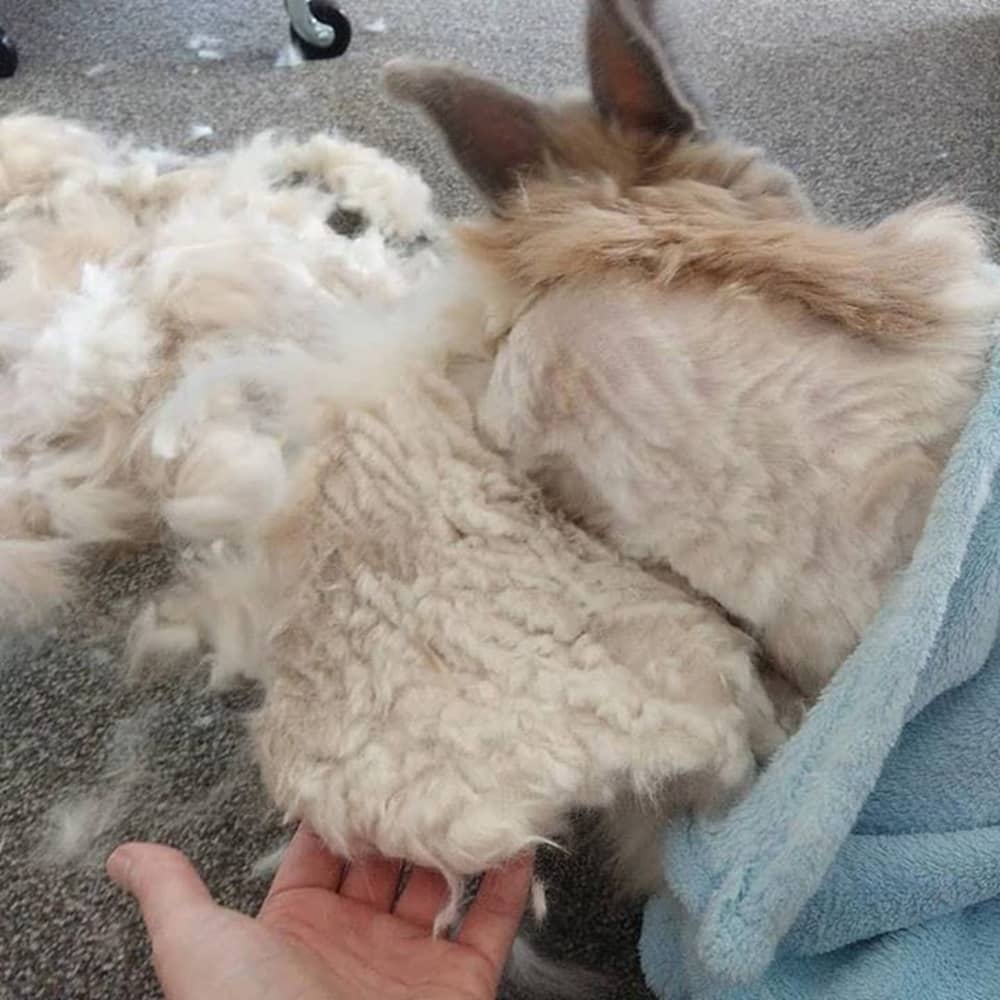
The basic grooming kit for an Angora Rabbit should have a slicker brush, nail clippers, and a steel comb. If you want to shear the wool you will need grooming clippers or scissors.
Reproduction and Breeding
If you’re considering breeding Angora rabbits, be prepared and informed. A typical litter consists of 6 to 8 kits. Breeding rabbits is a big responsibility, so make sure you’re ready to care for the offspring or find them good homes.
Pros and Cons of Keeping an Angora Rabbit as a Pet
Pros
Keeping an Angora rabbit comes with several benefits, making them a rewarding choice for pet owners and fiber enthusiasts alike. Here are some of the pros of having an Angora rabbit:
- Have a unique and beautiful appearance: The Angora rabbits have an attractive personality. Their fluffy, woolly appearance is visually striking, making them a unique and attractive addition to any household or rabbitry.
- Friendly and social: Angora rabbits are known for their gentle and calm demeanor, making them excellent pets for families and individuals.
- Produce luxurious wool: Angora rabbits produce a soft, luxurious wool that is highly valued in the textile industry. This wool can be harvested regularly and used for spinning, knitting, and other fiber arts.
- Have a relatively long lifespan: They have a lifespan of around 7-12 years and hence give a long companionship to the owners.
- Can be litter-trained: The Angora Rabbits are intelligent and learn to use a litter box.
Overall, keeping Angora rabbits offers a blend of practical, educational, and emotional benefits, making them a unique and rewarding choice for various types of pet owners and fiber enthusiasts.
Cons
- Require extensive grooming: As Angora rabbits are fluffy with long wool, they need regular grooming to prevent matting. This can be time-consuming and needs commitments from the owner.
- Are prone to wool block and other health issues: Angora rabbits may choke their digestive tract by ingesting loose wool. They need brushing and shearing to avoid this condition.
- Expensive: The initial setup cost of habitat, grooming kit, high-quality food supplies, and visits to the vet can be very expensive.
- Have higher upkeep costs: They need a specialized diet rich in protein to keep their wool shining. Moreover, they need regular grooming which adds up to higher upkeep costs.
- Can be sensitive to temperature changes: Angoras have dense wool so they need to be protected from higher temperatures.
- Need regular exercise and interaction: Angora Rabbits need daily exercise to keep themselves healthy. They need ample space to move around comfortably, which may require a larger cage or dedicated living area.
Overall, while Angora rabbits can be rewarding pets, they require a significant investment of time, effort, and resources. Potential owners should carefully consider these factors and ensure they are fully prepared for the responsibilities involved in caring for an Angora rabbit.
Related Species
Angora rabbits are a breed of domestic rabbit, Oryctolagus cuniculus. Other popular rabbit breeds include the
- Flemish Giant,
- Dutch, and
- Rex rabbits.
Interesting Facts About Angora Rabbits
- Angora rabbits are among the oldest domestic rabbit breeds.
- Their wool is softer than cashmere. Their super soft and long fur makes them look like big and cuddly fluff balls!
- They originated in Turkey.
- Angora wool is highly prized in the textile industry. It is known for its softness, silky texture, and fluffiness referred to as a halo.
- They can produce up to a pound of wool annually and therefore their diet should be rich in protein as compared to other breeds of rabbits.
- They have a lifespan of 7 to 12 years.
- Their fur needs daily grooming to prevent matting.
- They are very social and love human interaction.
- They can be litter trained.
- Angora wool is harvested by shearing, plucking, or combing.
- The Angora Rabbits are available in various colors.
- Angora Rabbits are more active at dawn or dusk.
- They use their keen senses to judge for any potential risk or danger near them.
- They can move their ears independently of each other.
- They can cost between $50 to $500.
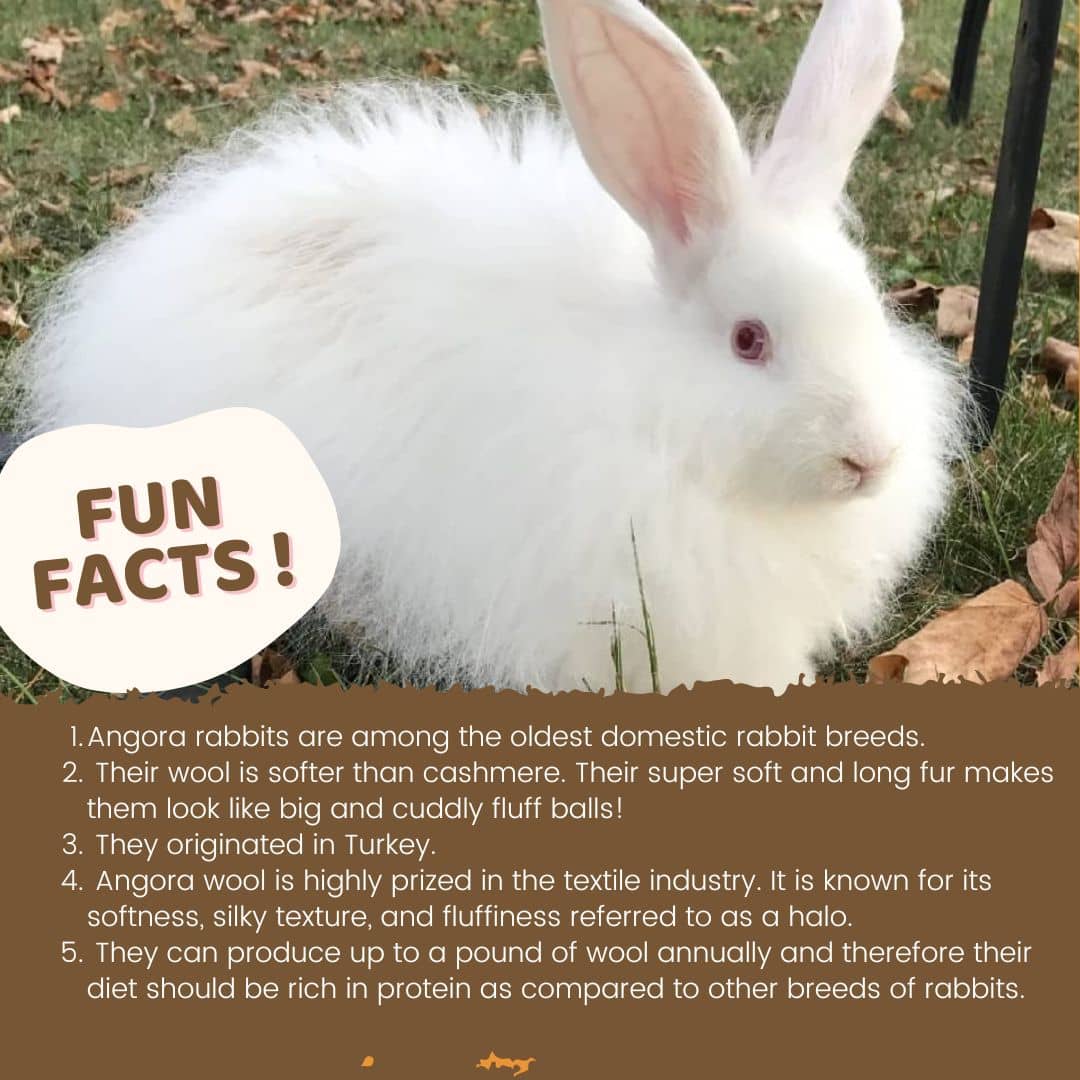
Frequently Asked Questions
Question1. Do Angora rabbits make good pets for children?
Answer: Yes, angora rabbits are friendly, cute, and playful creatures, and keeping them as pets is quite rewarding. But they should be supervised with young children.
Question2. What are the common health issues in Angora rabbits?
Answer: Wool block, Flystrike, dental problems, and respiratory infections are some of the common health concerns in Angora rabbits.
Question 3. Can angora rabbits be litter-trained?
Answer: Yes, these rabbits can be litter trained using a litter box with paper-based litter.
Question 4. Can I keep an Angora rabbit outdoors?
Answer: While possible, indoor housing is safer due to predators and weather conditions. Moreover, they don’t catch up bacterial infections
Question 5. Are Angora rabbits hard to take care of?
Answer: Angora Rabbits are high maintenance as they need regular grooming, a well-balanced nutritious diet, and exercise. They need daily brushing and shearing every 3 to 4 months.
Question 6. How much Angora bunnies cost?
Answer: They can cost around $50- $500 depending upon age and breed.
Question 7. How long do Angora bunnies live?
Answer: In captivity, the lifespan of an Angora rabbit is around 7 to 12 years.
Question 8. How friendly is Angora?
Answer: The Angora rabbits are calm, and incredibly affectionate and love to snuggle in the arms of their owner. They are social and enjoy human interaction.
Question 9. How often should I clean my Angora rabbit’s cage?
Answer: You should spot clean daily and perform a thorough cleaning weekly.
Question 10. How much wool can an Angora rabbit produce?
Answer: Most Angora shed their wool every 3-4 times a year. English and French Angora shed 85-110g each time and hence 350- 450 g(12-16Oz) each year.
